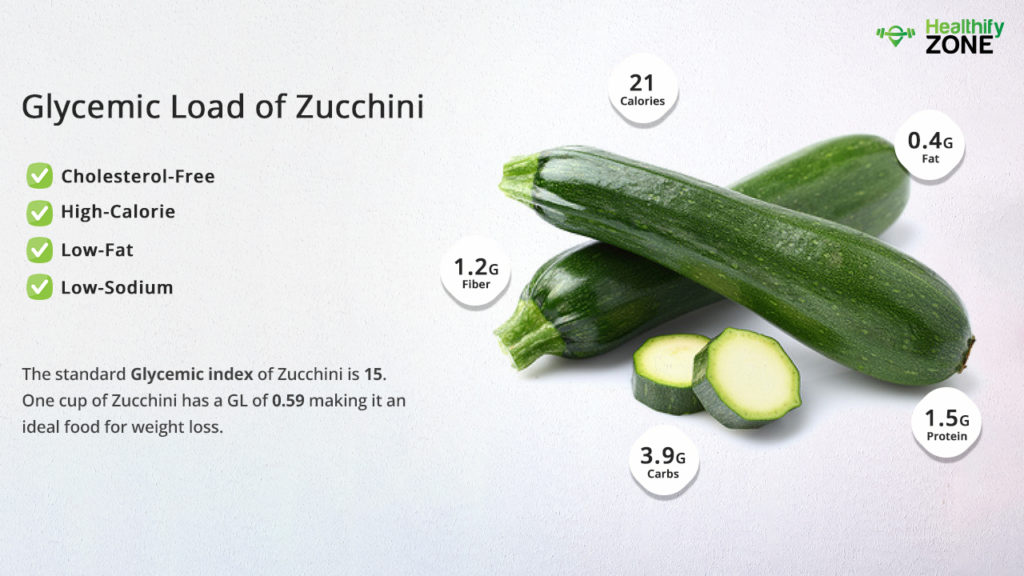The Glycemic Load is the measurement of the carbohydrate content of food with the pace with which it increases the blood glucose levels. The Glycemic Index is a simple way of making healthy diet choices. It is helpful in comparing and finding alternative sources of nutrients in terms of blood glucose levels. Glucose has a higher representation of blood glucose response in comparison to fructose.
Zucchini is often considered a vegetable, but botanically, it is a fruit. It is alternatively called courgette and is summer squash. According to the International GI Tables, zucchini’s glycemic index is 15, which is low. It is famously used in folk medicine to treat colds, aches, and a variety of other health conditions. It is rich in nutrients. Cooked zucchini has a similar nutrition profile as raw zucchini, but with a lesser amount of Vitamin A and C, both of which get reduced by cooking.

Zucchini is full of vitamins, minerals, and other beneficial plant compounds like
- Fiber
- Vitamin A
- Manganese
- Vitamin C
- Potassium
- Magnesium
- Vitamin K
- Folate
- Copper
- Phosphorous
- Vitamin B6
- Thiamine
How to Calculate Glycemic Load of Zucchini?
The standard Glycemic index of zucchini is 15. The high glycemic index of the fruit helps in reducing the risks related to cardiovascular diseases. If we want to talk about diet, the key to prevent diabetes or any chronic illness is to distribute the carbohydrate consumption content throughout the day and manage the sugar levels in the body correctly—the glycemic load for one cup of chopped zucchini is 0.59 approximately which makes it an extremely favorable food for salads, pasta, and more.
The Formula/Procedure For Calculation of Glycemic Index of the Zucchini :
GL = GI * carbs / 100
where
- GL – glycemic load;
- GI – glycemic index;
- and carbs – the amount of carbohydrates in the portion.

| SL.NO | ZUCCHINI BY WEIGHT IN (g) | GLYCEMIC LOAD |
| 1. | 100 g of Zucchini | 0.465 (low) |
| 2. | 250 g of Zucchini | 1.16 (low) |
| 3. | 500 g of Zucchini | 2.32 (low) |
| 4. | 1 Kg of Zucchini | 4.65 (low) |
| 5. | One Whole Zucchini | 0.9 (low) |
| 6. | 1 Cup of Zucchini (124 g) | 0.59 (low) |
Is Zucchini Safe to Consume If You Have Diabetes?
Zucchini may be effective in helping lower blood sugar levels in people who have type-2 diabetes. Zucchini has particularly low carbs. If one who is diabetic consumes a low-carb diet, their blood sugar and insulin levels will significantly get lower, which will keep the blood sugar levels stable and reduce the need for medication in people who have type to diabetes. The fiber present in zucchini helps in stabilizing blood sugar levels and in increasing insulin sensitivity. Thus, zucchini is an excellent choice if you have diabetes.
Can I Eat Zucchini During a Fat-Loss Diet?
You can eat zucchini during a strict fat-loss diet. You can limit yourself to about 300 g zucchini per serving.

- A 300 g serving of zucchini has a GL of 1.395 which is in the permissible levels.
- Zucchini as a salad ingredient is premissible in a fat-loss diet.
Can I Eat Zucchini During a Low-Carbohydrate Diet?
You can have zucchini when you are on a low-carbohydrate diet. It is an excellent alternative to white pasta. A cup of cooked zucchini, which is approximately 232 g, would have 3 g of carbs. You can use it in several ways and consume it.
Is Zucchini High in Sugar?
Zucchini is rich in water and has a very low-calorie density. 100 g of zucchini has 3.1 g of carbs and 2.5 g of sugar. Zucchini is very low on carbs and sugar, which makes the perfect go-to when you are diabetic, avoid fatty food, and look for a low-carb option.
- Zucchini has very low carbohydrate content is better than many other fruits.
- It is versatile and can be eaten both way, raw and cooked.